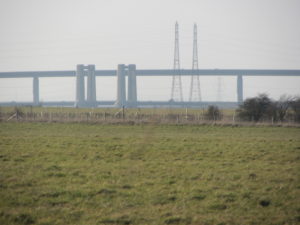Five miles south of Bakewell, on the A515 near the village of Parsley Hay in the Derbyshire Peak District, lies Arbor Stone Circle, known as the Stonehenge of the North.
The circle is located in a field off a farm track and the farmer, who owns right of way, may charge a small access fee – we found a tin box placed near the gate for this purpose.
It was October when we were visiting Derbyshire and spotted this place while looking around for ‘attractions’ in the area. We drove around some colourful autumnal countryside before driving off the A515, and following a sign for the stone circle on an access track for a short distance. We found a place to park the car on the right, just a short distance from the farm house. At this point the Circle was not clear to spot, and we had to proceed on foot, following a sign through a farm gate and up the hill among the grazing sheep to the location, where today, the stones are laying flat.
From the expanse of the area, this must have been a huge complex of standing stones in it’s day!
The name ‘Arbor Low’ appears to derive from ‘Eorthburg Hlaw,’ meaning ‘earthwork mound.’ It consists of a huge circular bank and internal ditch surrounding a central area, which in turn, encloses a flat plateau. From up here, you get a fantastic view over the Derbyshire countryside.
In the flattened area is a flat stone circle of white, weathered limestone blocks and in the centre is a group of four stones. It has often been described as resembling a ‘clock face’ from it’s unique arrangement. Whether the stones were ever in an upright position, has never been established, especially as no socket holes have ever been discovered.
The bank, today, averages a height of 2.1 metres with it’s circular crest diameter measuring 79 x 75 metres. Two gaps in the ditch and bank form wide entrances to the north west and south east. There is also an earthwork, leading from the site at the south east.
In the central area are the ruined and fallen remains of more than 50 large slabs and fragments of a large stone circle.
It is thought that when it was built it would have probably had somewhere between 41 and 43 stones in the ring which would have been set upright, and would have had a similar resemblance, on a smaller scale, to the neolithic monument at Avebury, in Wiltshire.
The surrounding landscape of Arbor Low is littered with barrows from the late Bronze Age, constructed about a thousand years after the henge was finished. One barrow was incorporated into the henge bank, and the largest barrow is known as Gib Hill, a short distance south.
The site was excavated from 1901 – 1902 and a human burial was discovered close to the stones that are thought to form a cove. No other discoveries of major significance were found at the time. In 1845, Thomas Bateman excavated the tumulus attached to the bank, and then, three years later, led an excavation at Gib Hill.
Gib Hill is so called because it was used as a hanging hill for a local murderer. The mound stands about 16 feet high. Excavations revealed a stone cist, containing a small clay urn and burned human bones.
Only after our visit did I discover the site is reported to have a plethora of ley lines running through it. During our time spent there, this aspect had already shown itself. For many years, I had not used my ‘straightened metal coat-hangers’ as ‘rods’ to detect any ley lines! How I originally came about to experience this strange phenomena was a great surprise at the time but that is a different story!
Out of curiosity only, I took the rods up to the site at Arbor Low and randomly walked around. It was a windy day and clouds had already gathered. Wind, will of course, move the rods. However, after walking for a while, the rods crossed sharply and you can feel the strength of force as they pull precisely. In fact I discovered three spots within a line where the same thing happened.
Arbor Low is thought to have been constructed between 2500 and 1700 BC. It is said, that a ley line passes through the SSE entrance.
Paul Screeton, a British journalist and author with a strong interest in Fortean phenomena is said to have spent the night at Arbor Low and was awakened by the spirits of ‘Atlanteans’ who explained the purpose of the structure to him! Screeton has speculated that England and Wales can be divided into 12 segments in an astrological scheme with each segment containing one primary and a number of secondary terrestrial zodiacs with the whole, being centred at Arbor Low. He has written a number of books, one as recently as 2010, and maybe he reveals more of his experience in one of these?
Ley lines appear to have two meanings. The older is that throughout Britain there are ancient, straight track ways in the landscape. The newer version is that there are spiritual and mystical alignments of land forms associated with ancient sites or holy places, such as stone circles, standing stones, and churches. In 1922 Alfred Watkins, a self-taught amateur archaeologist and antiquarian, had a book published called Early British Trackways, should anyone be interested in the subject!
As for myself, although fascinated by the concepts, I am sure no one really knows the true facts behind this strange phenomena. Maybe, when we leave this ‘earthly world’ we shall be enlightened!
As we continued our ‘wanderings’ the amassing clouds were approaching and the wind factor turned the air really cold. Even the sheep seemed to be aiming closer to the stone wall for means of some shelter. We scrambled down the hillside and hurriedly returned to the car to make our way back to Makeney Hall Hotel where we were staying for a couple of days.









